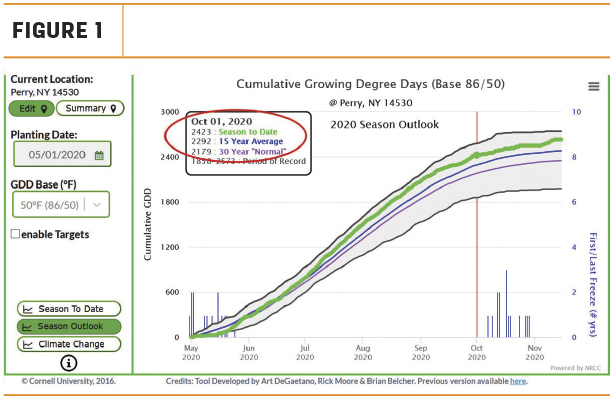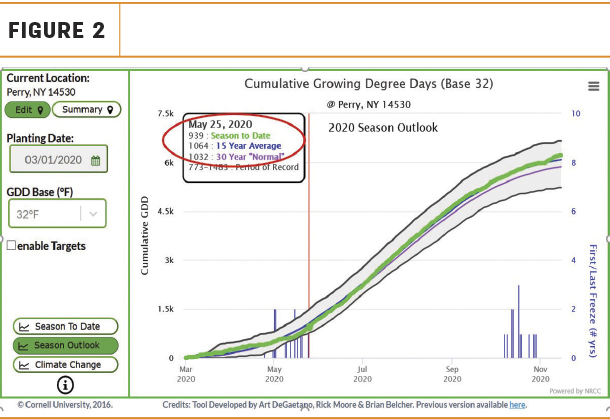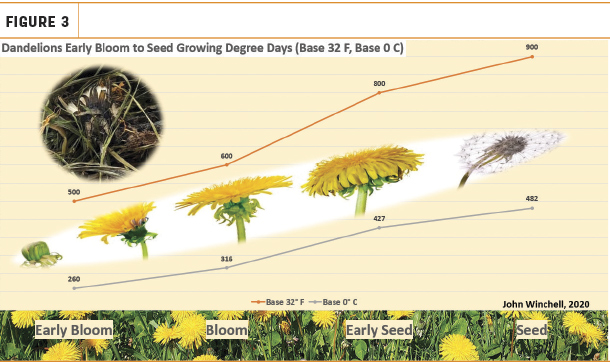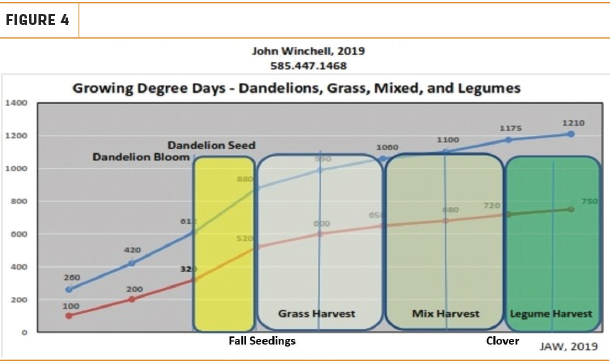Analytics have become a critical part in all facets of our lives, even if we don’t know it. Whether it is sports, business, weather or even politics, analytics play a vital role in our decision-making. The same holds true for the dairy industry, as analytics have been around for a while with activity monitors, dairy production records, sire summaries and chopper monitors, to name a few.
Now we can add forage harvest analytics to that list.
Forage harvest analytics are a combination of current and historical weather trends, and their relationship with the climate, seasonal patterns and soil types of farms. The goal is to combine in-field monitoring and fine-tune harvest windows with the use of phenology.
Phenology
The science of phenology is the study of cyclic and seasonal natural phenomena, especially in relation to climate, plant and animal life. In other words, it is what Mother Nature does every year during the seasons, and how plants and animals react. Vegetable and tree farmers understand this science, and most have perfected it. Even in agronomy, our rival the alfalfa weevil is controlled by cutting and using applications based on phenology.

Growing degree days (GDD) are a tool used in phenology and are a measure of heat accumulation to predict plant growth in a season. Plants require a certain amount of temperature to progress through their life stages to maturity. Other factors that impact plant growth include moisture and light photoperiod. A great analytic website on phenology can be found online (USA National phenology network).
2020: A tale of two seasons
Last year was an interesting year, to say the least, and for the weather and direct effects on plants, it was a tale of two seasons, especially in the East. The spring temperatures were cool, which resulted in a lower GDD accumulation compared to typical seasonal temperatures leading up to the beginning of June. Just like smoking a good piece of meat, this low and slow growing season resulted in first-cutting haylage with excellent digestibility. Some tonnage was less than normal, but if it was made at the correct time, loss was made up for with a higher-yielding second cutting.
Then, in June, someone turned up the heat a little extra and temperatures soared into September. This created excellent corn growth that hadn’t been seen in years. Many areas in the East also experienced drought conditions. For those who did get some rain, they were harvesting corn silage two to three weeks earlier than normal. These conditions had a few farmers thinking that maybe next year they would grow longer-day corn, but make sure to review the analytical tools available for your farm and area to help make those kinds of decisions.
Growing degree days
We have been using GDDs for many years in agriculture, and we have dabbled with it on alfalfa and maturity prediction. As a nutritionist, I remember reading a great article in the early 2000s from Michigan State Extension on tracking GDDs on alfalfa. Work from Mike Allen’s research suggested matching GDDs against neutral detergent fiber (NDF) levels. In using base 41, which is the GDD based on legume growth being counted for average daily temperatures over 41ºF, GDDs of 750 will equate to approximately 40 NDF.

To put this into perspective using an older analytic such as relative feed value (RFV), there is the “prime” alfalfa number of the 20,30,40 rule. This rule is where 20 crude protein (CP), 30 acid detergent fiber (ADF) and 40 NDF will equate to 150 RFV, which is what we look for as the starting goal for haylage for lactating cows. Reducing the GDDs to 680 GDD will equate to 38% NDF. We know that NDF traditionally was a great predictor of intake, and we have made advances in the last few years on forage quality and the digestibility of NDF. Forage testing labs do a wonderful job with NDFd30, uNDF240 and, very soon, NDFd12. These numbers are critical, and many dairy managers need to know these numbers and how to achieve the quality inside of the NDF.
Dandelions
Dandelions are everywhere, and everyone has them. They are loved for their pollen-laden flowering sign of spring and hated for their filter-clogging, allergy-inducing seedings. Our forefathers watched nature’s signs to predict harvest practices – such as when dandelions go to seed, it is time to harvest first-cutting grass.

This is a great empirical guide, and analytics can assist in making those decisions of when is the right time to harvest. I began counting GDDs in the East and Upper Midwest beginning on March 1, 2020. Dandelions begin to go to seed around 850 GDD, and early cool-season grasses begin to head approximately at 900 GDD (base 32). So keep this in the back of your mind when deciding to plant corn or harvest first cutting.
What about grass?
Anyone who has planted alfalfa/grass seedings has debated the question of when to harvest your crop. If you mow early and capture the quality of the grass prior to heading-out, you will shave the alfalfa off before it is ready. This can be risky, as you want maximum tonnage but you also do not want to injure the alfalfa stand. There are many areas where alfalfa is not an option and grass varieties are the logical seeding choice.

Knowing that the stem-based alfalfa differs from the blade-based grasses, there are stark differences in digestibility and maturity characteristics of grasses. Grasses mature earlier than legumes due to various factors, but I will focus on grass GDDs. Cool-season grass species will grow from a different GDD base than alfalfa, which is base 32ºF. Knowing this introduces a whole new world of analytics and explains why cool-season grasses and fall seedings grow so well in the spring compared to legumes.
In the real world, you’ll want to use a combination of analytics and gut instinct. Using GDDs as a rule for harvest is a good practice, but you should also get out into the field and split stems, measure heights, take pre-harvest forage samples and check the weather forecast. We need to combine old- and new-school techniques to set up a successful harvest season with maximum quality and adequate cuttings. Forage harvest analytics can make a huge difference in your forage program and your bottom line.
References omitted but are available upon request by sending an email to the editor.









